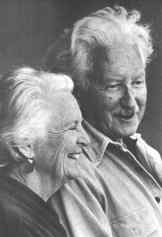ERIK ERIKSON
1902 - 1994
Dr. C. George Boeree
Erik Erikson was born in Frankfurt, Germany, on June 15, 1902. There
is a little mystery about his heritage: His biological father was an
unnamed
Danish man who abandoned Erik's mother before he was born. His mother,
Karla Abrahamsen, was a young Jewish woman who raised him alone for the
first three years of his life. She then married Dr. Theodor Homberger,
who was Erik's pediatrician, and moved to Karlsruhe in southern
Germany.
We cannot pass over this little piece of biography without some
comment:
The development of identity seems to have been one of his greatest
concerns
in Erikson's own life as well as in his theory. During his childhood,
and
his early adulthood, he was Erik Homberger, and his parents kept the
details
of his birth a secret. So here he was, a tall, blond, blue-eyed boy who
was also Jewish. At temple school, the kids teased him for being
Nordic;
at grammar school, they teased him for being Jewish.
After graduating high school, Erik focussed on becoming an artist.
When
not taking art classes, he wandered around Europe, visiting museums and
sleeping under bridges. He was living the life of the carefree rebel,
long
before it became "the thing to do."
When he was 25, his friend Peter Blos -- a fellow artist and, later,
psychoanalyst -- suggested he apply for a teaching position at an
experimental
school for American students run by Dorothy Burlingham, a friend of
Anna
Freud. Besides teaching art, he gathered a certificate in Montessori
education
and one from the Vienna Psychoanalytic Society. He was psychoanalyzed
by
Anna Freud herself.
While there, he also met Joan Serson, a Canadian dance teacher at
the
school. They went on the have three children, one of whom became a
sociologist
himself.
With the Nazis coming into power, they left Vienna, first for
Copenhagen,
then to Boston. Erikson  was
offered a position at the Harvard Medical School and practiced child
psychoanalysis
privately. During this time, he met psychologists like Henry Murray and
Kurt Lewin, and anthropologists like Ruth Benedict, Margaret Mead, and
Gregory Bateson. I think it can be safely said that these
anthropologists
had nearly as great an effect on Erikson as Sigmund and Anna Freud!
was
offered a position at the Harvard Medical School and practiced child
psychoanalysis
privately. During this time, he met psychologists like Henry Murray and
Kurt Lewin, and anthropologists like Ruth Benedict, Margaret Mead, and
Gregory Bateson. I think it can be safely said that these
anthropologists
had nearly as great an effect on Erikson as Sigmund and Anna Freud!
He later taught at Yale, and later still at the University of
California
at Berkeley. It was during this period of time that he did his famous
studies
of modern life among the Lakota and the Yurok.
When he became an American citizen, he officially changed his name
to
Erik Erikson. Erikson's son, Kai Erikson, believes it was just a
decision to define himself as a self-made man: Erik, son of Erik.
In 1950, he wrote Childhood and Society, which contained summaries
of
his studies among the native Americans, analyses of Maxim Gorkiy and
Adolph
Hitler, a discussion of the "American personality," and the basic
outline
of his version of Freudian theory. These themes -- the influence of
culture
on personality and the analysis of historical figures -- were repeated
in other works, one of which, Gandhi's Truth, won him the Pulitzer
Prize
and the national Book Award.
In 1950, during Senator Joseph McCarthy's reign of terror, Erikson
left
Berkeley when professors there were asked to sign "loyalty oaths." He
spent
ten years working and teaching at a clinic in Massachussets, and ten
years
more back at Harvard. Since retiring in 1970, he wrote and did research
with his wife. He died in 1994.
Copyright 1997, 2006 C. George Boeree
 was
offered a position at the Harvard Medical School and practiced child
psychoanalysis
privately. During this time, he met psychologists like Henry Murray and
Kurt Lewin, and anthropologists like Ruth Benedict, Margaret Mead, and
Gregory Bateson. I think it can be safely said that these
anthropologists
had nearly as great an effect on Erikson as Sigmund and Anna Freud!
was
offered a position at the Harvard Medical School and practiced child
psychoanalysis
privately. During this time, he met psychologists like Henry Murray and
Kurt Lewin, and anthropologists like Ruth Benedict, Margaret Mead, and
Gregory Bateson. I think it can be safely said that these
anthropologists
had nearly as great an effect on Erikson as Sigmund and Anna Freud!